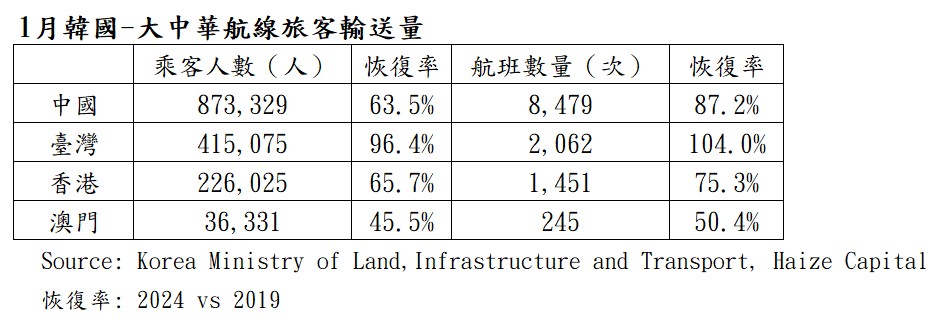

登錄


登錄
海擇短評 Haize Comment:
日本人口數1.26億是韓國人口數5,174萬的2.5倍,但是2023年韓國的出境旅客數達2,030萬,卻是日本出境旅客數962萬的翻倍,因此任何作入境旅遊市場的東亞國家/旅遊企業,都不可能忽視韓國的出境旅客。時值2024年Q1,值得注意的有兩點:首先,韓國出境旅客的意向,相對2023年赴日獨大的趨勢有變動嗎?其次,可有新的增長曲線值得期待?
根據韓國國土交通部(국토교통부, Ministry of Land,Infrastructure and Transport)的2024年1月總結數據,第一個答案是"No"。日本不但仍然是韓國出境旅客的首選,而且還創下歷史新高,達85.7萬人次,較2019年同期增長10%,也較上月(2023年12月)增長10%,看來這個趨勢本身不會改變,值得投資人留心的是韓國旅客是否會提高對日本非一線城市的旅遊深度。
至於是否有新的增長曲線值得期待?對於第二個答案,海擇資本認為是"Yes"。就1月數據來看,韓國與大中華區的旅客輸送量正在快速復甦,該月大陸、台灣、香港、澳門航線(結合出發及抵達)的總旅客輸送量超過155萬人次,佔國際旅客總輸送量(728萬人次)的21.3%。其中韓國-中國航線的旅客輸送量為87萬人次,與2023年同期相比增長7倍以上,與2019年同期相比復甦63.5%;韓國-台灣航線的旅客輸送量為42萬人次,與2023年同期相比增長2倍以上,與2019年同期相比復甦96.4%;韓國-香港航線的旅客輸送量為23萬人次,與2019年同期相比復甦65.7%。
由於國土交通部所公告旅客輸送量的源數據是機場航班的吞吐量,所以這數據既涵蓋韓國赴大中華區的旅客,也涵蓋大中華區赴韓國的旅客,且一個旅客的往返會被算做兩個人次。整體來說,若將韓國出境赴中港台的數據與赴日數據對比,其實並不算太大,海擇資本推估總數約35萬人,大概只有赴日的40%左右。但是若跟去年的中港台數據自己對比,增速則相當驚人,是值得關注的第二成長曲線。
----------
Japan's population of 126 million is almost 2.5 times that of South Korea's 51.74 million. However, in 2023, South Korea's outbound travelers reached 20.3 million, doubling Japan's outbound travelers at 9.62 million. Therefore, any East Asian country or travel enterprise targeting the inbound tourism market cannot overlook South Korean outbound travelers. As of Q1 2024, two points are noteworthy: First, will there a change in the trend of South Korean outbound travelers' preferences, compared to the predominant trend of visiting Japan in 2023? Second, is there a new growth curve to look forward to?
According to the summary data from the Ministry of Land, Infrastructure and Transport of South Korea for January 2024, the answer to the first question is "No." Japan remains the top choice for South Korean outbound travelers, even setting a new record with 857,000 visitors. This marks a 10% increase from the same period in 2019 and a 10% increase from the previous month (December 2023). It appears this trend will not change. Investors should note whether South Korean travelers will increase their travel depth to Japan's non-major cities.
Regarding new growth curve, Haize Capital believes there is. According to January's data, passenger traffic between South Korea and Greater China is rapidly recovering, the total passenger traffic for mainland China, Taiwan, Hong Kong, and Macau routes (combining departures and arrivals) exceeded 1.55 million, accounting for 21.3% of the total international passenger traffic of 7.28 million. Specifically, the South Korea-China route had 870,000 passengers, a more than sevenfold increase compared to the same period in 2023 and a 63.5% recovery compared to the same period in 2019; the South Korea-Taiwan route had 420,000 passengers, more than doubling from the same period in 2023 and recovering 96.4% compared to 2019; the South Korea-Hong Kong route had 230,000 passengers, recovering 65.7% compared to the same period in 2019.
Since the passenger traffic data announced is based on flight throughput, it covers both passengers traveling from South Korea to Greater China and from Greater China to South Korea, with a round trip by a single passenger counted as two entries. In comparison, the number of South Korean travelers to China, Hong Kong, and Taiwan versus those to Japan is not significantly large, estimated by Haize Capital to be around 350,000, approximately 40% of those traveling to Japan. However, when compared to last year's data for China, Hong Kong, and Taiwan, the growth rate is quite remarkable, making it a second growth curve worth paying attention to.
----------
일본 인구는 1억2,600만명으로 한국 전체 인구(5,174만명)의 거의 2.5배에 달한다. 그러나 2023년 한국의 해외여행자 수는 2,030만명으로 일본 해외여행자 962만명의 두 배에 이른다. 그러므로 입국여행시장을 겨냥하는 그 어떤 동아시아국가나 여행사도 출국 한국인 수를 홀시해서는 안된다. 2024년 1분기까지 두 가지 주목할 점이 있다. 첫째, 2023년 방일 여행의 주도적 추세에 비해 해외여행 한국인수의 선호 추세가 바뀔 것인가? 둘째, 새로운 성장곡선이 기대되는가?
국토교통부 항공정보포털시스템에 따르면 첫 번째 질문의 답은 '아니오'였다. 일본은 여전히 한국인 가장 선호하는 해외 여행지이다 85만7,000명을 기록하기도 했다. 이는 2019년 동기대비 10%, 지난달(2023년 12월)보다는 10% 증가한 것이다. 이 추세는 변하지 않을 것 같다. 투자자들이 더욱 주의해야 할 것은 한국 여행객들이 일본의 주요 도시가 아닌 도시를 찾는 관광 깊이를 늘릴지 여부다.
새로운 성장곡선에 대해 하이저 캐피털은 "있다"고 생각했다. 중화권 노선이 살아나고 있다. 중국과 대만, 홍콩, 마카오 노선 1월 이용객 수가 출도착 합계 기준 155만명을 넘어서며, 전체 국제선 여객수(728만명)의 21.3%를 차지했다. 이 가운데 중국 노선 이용객은 87만명으로 전년동월대비 7배 이상, 2019년 동월대비 63.5% 증가했다. 대만 노선 탑승객은 42만명으로 전년동월대비 2배 이상, 2019년 동월대비 96.4%까지 회복했다. 홍콩 노선은 23만명이 이용하며 2019년 1월 대비 65.7%까지 회복했다.
국토교통부가 발표한 여객 수송량 데이터는 항공편 물동량을 기반으로 하기 때문에 이 데이터는 한국에서 중화권으로, 중화권에서 한국으로 가는 승객을 포함하며, 이 중 한 승객은 왕복 한 번을 두 번으로 계산한다. 전체적으로 보면 중국 · 홍콩 · 대만에 여행가는 한국인과 방일 한국인과 별 차이가 없었다. 하이저 캐피털은 중국 · 홍콩 · 대만에 여행가는 한국인은 방일 한국인의 40% 수준인 약 35만명에 이를 것으로 추산한다. 하지만 지난해 중국, 홍콩, 대만 수치와 비교하면 상당히 빠른 증가율이다. 이것은 주목할 만한 제2의 성장 곡선이 될 것이다.

標籤 Label: Japan South Korea Inbound Outbound